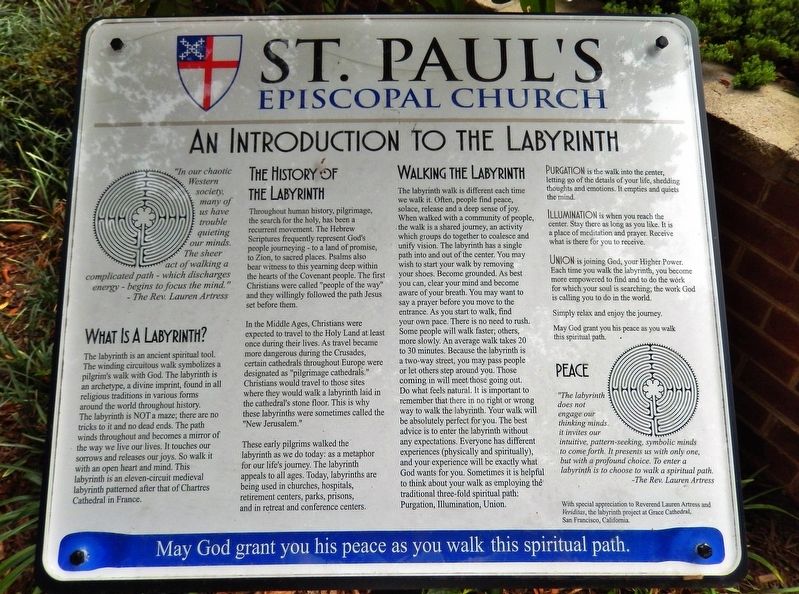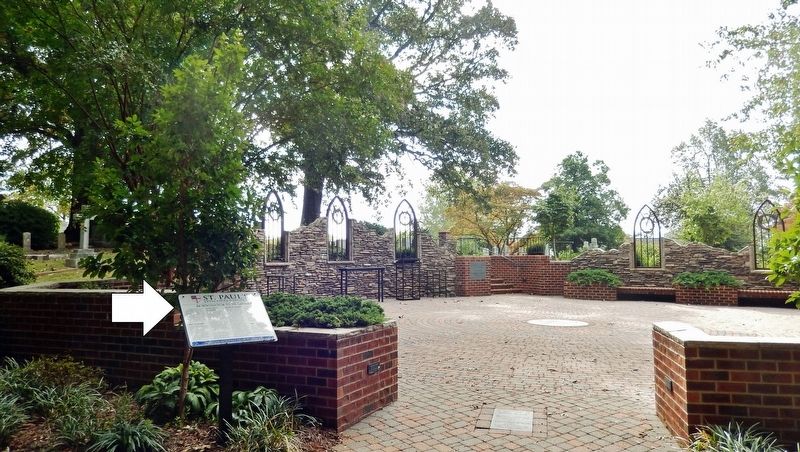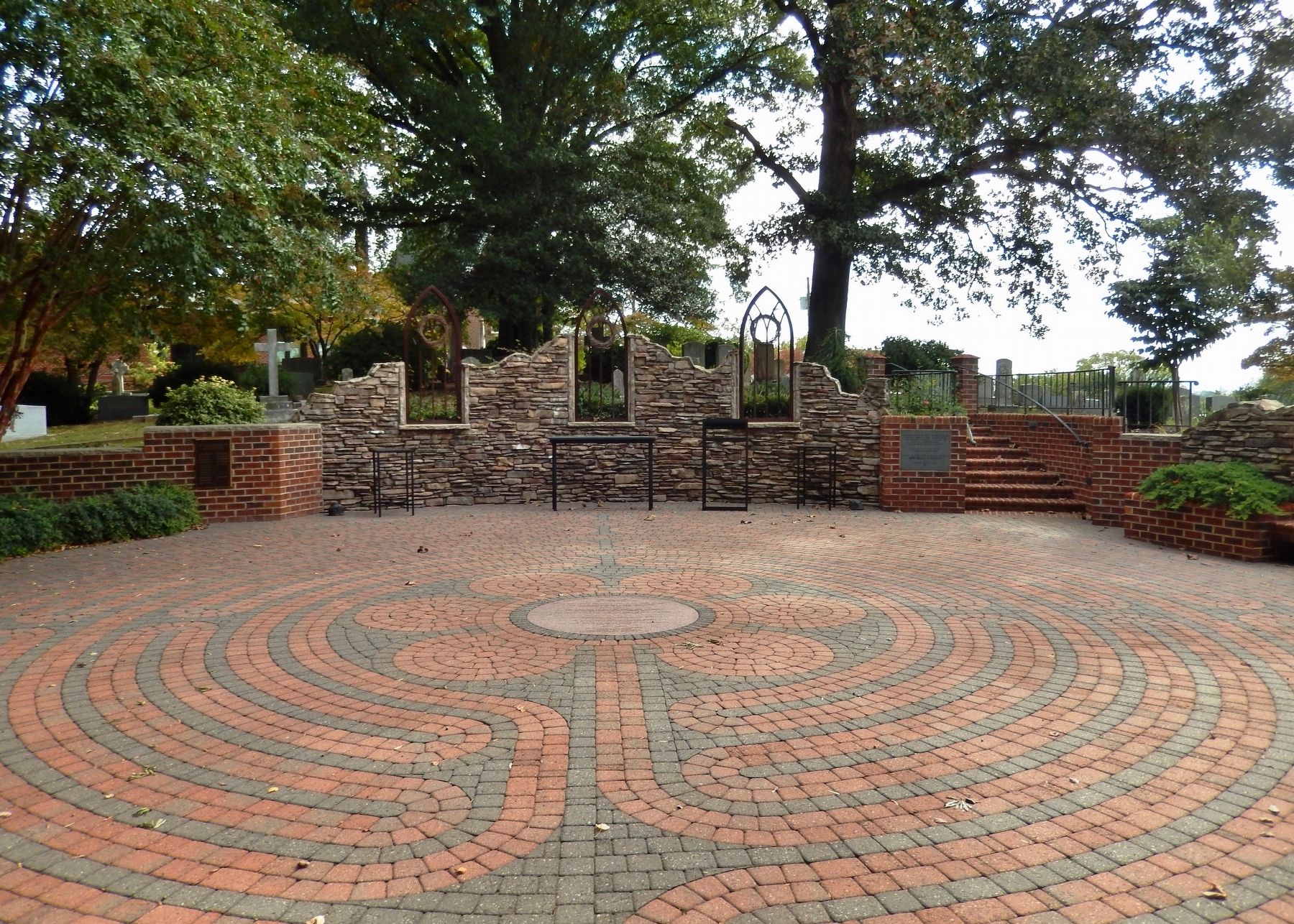Wilkesboro in Wilkes County, North Carolina — The American South (South Atlantic)
An Introduction to the Labyrinth
St. Paul's Episcopal Church
"In our chaotic Western society, many of us have trouble quieting our minds. The sheer act of walking a complicated path — which discharges energy — begins to focus the mind."
—The Rev. Lauren Artress
What is a Labyrinth?
The labyrinth is an ancient spiritual tool. The winding circuitous walk symbolizes a pilgrim's walk with God. The labyrinth is an archetype, a divine imprint, found in all religious traditions in various forms around the world throughout history. The labyrinth is NOT a maze; there are no tricks to it and no dead ends. The path winds throughout and becomes a mirror of the way we live our lives. It touches our sorrows and releases our joys. So walk it with an open heart and mind. This labyrinth is an eleven-circuit medieval labyrinth patterned after that of Chartres Cathedral in France.
The History of the Labyrinth
Throughout human history, pilgrimage, the search for the holy, has been a recurrent movement. The Hebrew Scriptures frequently represent God's people journeying — to a land of promise, to Zion, to sacred places. Psalms also bear witness to this yearning deep within the hearts of the Covenant people. The first Christians were called "people of the way" and they willingly followed the path Jesus set before them.
In the Middle Ages, Christians were expected to travel to the Holy Land at least once during their lives. As travel became more dangerous during the Crusades, certain cathedrals throughout Europe were designated as "pilgrimage cathedrals." Christians would travel to those sites where they would walk a labyrinth laid in the cathedral's stone floor. This is why these labyrinths were sometimes called the "New Jerusalem."
These early pilgrims walked the labyrinth as we do today: as a metaphor for our life's journey. The labyrinth appeals to all ages. Today, labyrinths are being used in churches, hospitals, retirement centers, parks, prisons, and in retreat and conference centers.
Walking the Labyrinth
The labyrinth walk is different each time we walk it. Often, people find peace, solace, release and a deep sense of joy. When walked with a community of people, the walk is a shared journey, an activity which groups do together to coalesce and unify vision. The labyrinth has a single path into and out of the center. You may wish to start your walk by removing your shoes. Become grounded. As best you can, clear your mind and become aware of your breath. You may want to say a prayer before you move to the entrance. As you start to walk, find your own pace. There is no need to rush. Some people will walk faster; others, more slowly. An average walk takes 20 to 30 minutes.
Because the labyrinth is a two-way street, you may pass people or let others step around you. Those coming in will meet those going out. Do what feels natural. It is important to remember that there is no right or wrong way to walk the labyrinth. Your walk will be absolutely perfect for you. The best advice is to enter the labyrinth without any expectations. Everyone has different experiences (physically and spiritually), and your experience will be exactly what God wants for you. Sometimes it is helpful to think about your walk as employing the traditional three-fold spiritual path: Purgation, Illumination, Union.
Purgation is the walk into the center, letting go of the details of your life, shedding thoughts and emotions. It empties and quiets the mind.
Illumination is when you reach the center. Stay there as long as you like. It is a place of meditation and prayer. Receive what is there for you to receive.
Union is joining God, your Higher Power. Each time you walk the labyrinth, you become more empowered to find and to do the work for which your soul is searching; the work God is calling you to do in the world. Simply relax and enjoy the journey. May God grant you his peace as you walk this spiritual path.
Peace
"The labyrinth does not engage our thinking minds, it invites our intuitive, pattern-seeking, symbolic minds to come forth. It presents us with only one, but with a profound choice. To enter a labyrinth is to choose to walk a spiritual path.”
—The Rev. Lauren Artress
With special appreciation to Reverend Lauren Artress and Veriditas, the labyrinth project at Grace Cathedral, San Francisco, California.
Topics. This historical marker is listed in this topic list: Churches & Religion.
Location. 36° 8.961′ N, 81° 9.339′ W. Marker is in Wilkesboro, North Carolina, in Wilkes County. Marker can be reached from the intersection of West Cowles Street and Woodland Boulevard, on the right when traveling west. Marker and labyrinth are located beside the parking lot on the west side of Saint Paul's Episcopal Church. Touch for map. Marker is at or near this postal address: 200 West Cowles Street, Wilkesboro NC 28697, United States of America. Touch for directions.
Other nearby markers. At least 8 other markers are within walking distance of this marker. St. Paul's Episcopal Church (within shouting distance of this marker); Wilkes County Frescoes (approx. 0.2 miles away); Former Federal Building (approx. 0.2 miles away); Captain Robert Cleveland Log Home (approx. 0.2 miles away); The Old Wilkes Jail (approx. 0.2 miles away); Robert Cleveland Log Home (approx. 0.2 miles away); Gray Brothers Furniture Company (approx. 0.2 miles away); Early Food Preservation (approx. 0.2 miles away). Touch for a list and map of all markers in Wilkesboro.
Related markers. Click here for a list of markers that are related to this marker. Saint Paul's Episcopal Church
Credits. This page was last revised on February 19, 2022. It was originally submitted on February 18, 2022, by Cosmos Mariner of Cape Canaveral, Florida. This page has been viewed 157 times since then and 15 times this year. Photos: 1, 2, 3. submitted on February 19, 2022, by Cosmos Mariner of Cape Canaveral, Florida.


